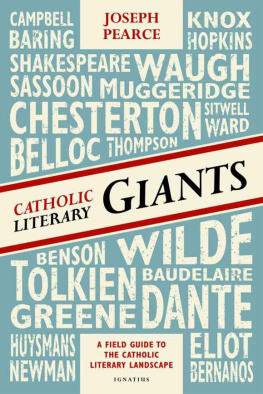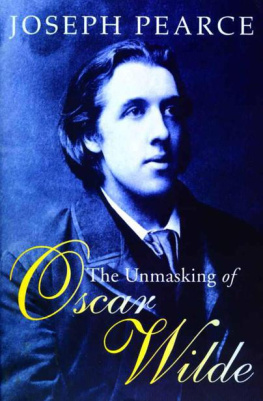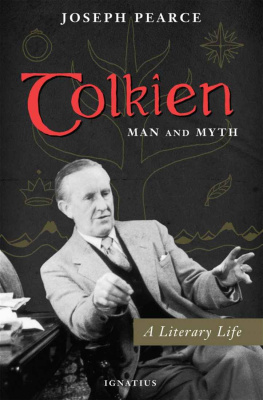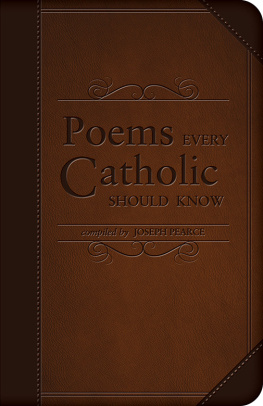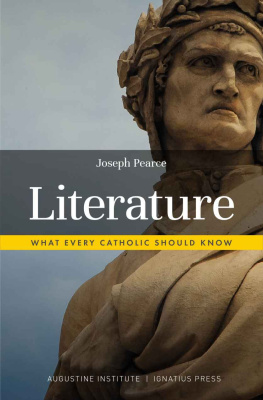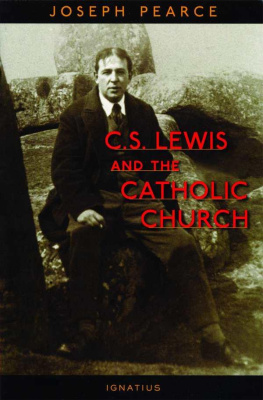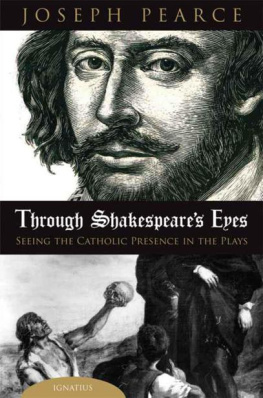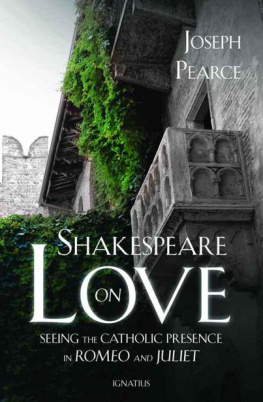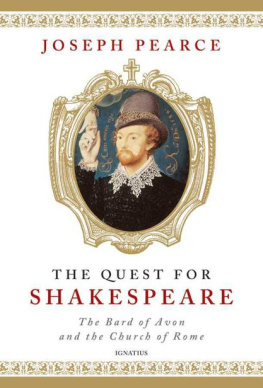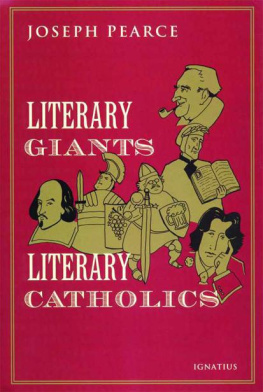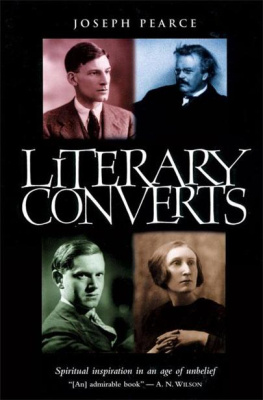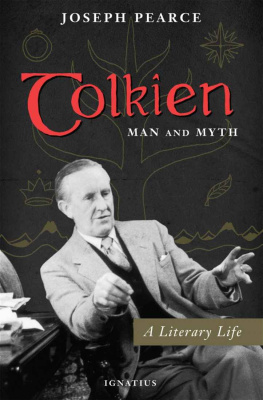CATHOLIC LITERARY GIANTS
JOSEPH PEARCE
CATHOLIC LITERARY GIANTS
A Field Guide to the
Catholic Literary Landscape
IGNATIUS PRESS SAN FRANCISCO
First Edition: Literary Giants, Literary Catholics
2005 by Ignatius Press
Cover design by John Herreid
Reprinted under new title in 2014 by Ignatius Press, San Francisco
All rights reserved
ISBN 978-1-58617-944-1
Library of Congress Control Number 2014908648
Printed in the United States of America
To Giovanna Paolina
CONTENTS
INTRODUCTION
PART ONE: TRADITION AND CONVERSION
PART TWO: THE CHESTERBELLOC
PART THREE: THE WASTELAND
PART FOUR: J. R. R. TOLKIEN AND THE INKLINGS
PART FIVE: MORE THINGS CONSIDERED
ACKNOWLEDGEMENTS
Most of the chapters in this volume have been published before in a variety of journals on both sides of the Atlantic. My memory is no longer equal to the task of remembering which articles appeared in which journals, but I can, I think, list the names of the journals in which they appeared. These include, in no particular order and with apologies for any sins of omission, the Catholic Herald , the Tablet, Crisis, Gilbert Magazine , the Chesterton Review, Lay Witness, This Rock, Christian History, Catholic Social Science Review , the Review of Politics, Faith and Reason , the National Catholic Register, Catholic World Report , the C. S. Lewis Journal, Chronicles , the Nicaraguan Academic Journal , the American Conservative , the Naples Daily News and National Review On-Line . My thanks are proffered to those many individuals who were responsible for commissioning and accepting these articles for the journals listed. I suspect, however, that the list is not complete and apologize, once again, for any lapses in memory.
Many of the chapters in Part V were originally published as articles in the Saint Austin Review (StAR) , the Catholic cultural journal of which I am coeditor. The article on Bellocs Path to Rome was originally written for, and published in, the Encyclopedia of Catholic Literature , edited by Mary R. Reichardt and published by Greenwood Press in 2004.
Grateful acknowledgements are due, and are wholeheartedly rendered, to Father Joseph Fessio, S.J., for his continuing faith in my work and for his valued advice during the preparation of this volume. Similar gratitude is due to Father Fessios colleagues at Ignatius Press, each of whom has worked tirelessly to bring this and my other volumes to fruition.
Final acknowledgement, as ever and always, goes to my ever-patient wife, Susannah, for all the support she gives and is, and to our two children: to Leo, our firstborn, and to little Giovanna Paolina, who rests in the arms of God.
INTRODUCTION
CONVERTING THE CULTURE:
The Evangelizing Power of Beauty
There is a story about an American tourist somewhere in the wilds of rural Ireland. He is hopelessly lost. Desperate for reorientation, he is relieved to see a rustic Irishman, sitting on a fence and sucking a straw. This man has probably lived here all his life, the American thinks to himself; he will surely be able to help. Excuse me, he says. How do I get to Limerick? The Irishman looks at him for a while and sucks pensively on his straw. If I were you, he replies, I wouldnt start from here.
Although one can obviously sympathize with the irate frustration that our lost American must have felt at the unhelpfulness of such a response, there is more than a modicum of wisdom in the Irishmans reply. Indeed, if the characters are changed, the whole story takes on something of the nature of a parable. Instead of an American tourist, imagine that the hopelessly lost individual is the present writer and that the rustic Irishman is Saint Patrick in disguise. The year is 1978 and I am in the Northern Irish city of Londonderry. I am there because, as an angry seventeen-year-old, I have become involved with the Protestant paramilitaries in Northern Ireland and with a white supremacist organization in England. I am angry. I am bitter. I am bigoted. I hate Catholicism and all that it stands for (although, of course, I have no idea what it really stands for, only what my prejudiced presumption believes that it stands for). Shortly afterward I will join the Orange Order, an anti-Catholic secret society, as a further statement of my Ulster loyalism and anti-Catholicism. During this visit to Londonderry, I take part in a day and a night of rioting during which petrol bombs are thrown and shops are lootedall in the name of anti-Catholicism. It is then, at least in the mystical fancy of my imagination, that I meet the rustic Irishman who is really Saint Patrick in disguise. I am lost, I say to him (though I am so lost that I dont even know that I am lost). How do I find my way Home? If I were you, the saintly Irishman replies, I wouldnt start from here.
Wise words indeed, though at the time they would have fallen on deaf ears. Deaf, dumb and blind, I had a long way to go. The long and winding road that would lead, eventually, eleven years later, to the loving arms of Christ and His Church would be paved with the works of great Catholic apologists such as Newman, Chesterton and Belloc. Newmans masterful Apologia and his equally masterful autobiographical novel, Loss and Gain ; Chestertons Orthodoxy, The Everlasting Man and The Well and the Shallows ; and Bellocs stridently militant exposition of the Europe of the Faitheach of these was a signpost on my path from homelessness to Home. There were, of course, others: Karl Adams The Spirit of Catholicism , Archbishop Sheehans Apologetics and Catholic Doctrine and Father Coplestons Saint Thomas Aquinas . I am, therefore, deeply indebted to the great apologists and, in consequence, retain the strongest admiration for those who continue the work of apologetics in our day. I hope and pray that the great work being done by This Rock and Catholic Answers will bring about a bumper harvest akin to that which was reaped by these great apologists of the past.
Although my own approach to evangelization is somewhat different, I share the same desire to win souls for Christ as do Karl Keating, Tim Ryland and Jerry Usher. I would, in fact, call myself an apologist, albeit an apologist of a different ilk. I would say that I am a cultural apologist, one who desires to win converts through the communicating power of culture.
Perhaps a short theological aside will serve as a useful explanation of how cultural apologetics is both different from, and yet akin to, the more conventional field of apologetics. Truth is trinitarian. It consists of the interconnected and mystically unified power of Reason, Love and Beauty. As with the Trinity itself, the three, though truly distinct, are one. Reason, properly understood, is Beauty; Beauty, properly apprehended, is Reason; both are transcended by, and are expressions of, Love. And, of course, Reason, Love and Beauty are enshrined in, and are encapsulated by, the Godhead. Indeed, they have their raison dtre and their consummation in the Godhead. Remove Love and Reason from the sphere of aesthetics and you remove Beauty also. You get ugliness instead. Even a cursory glance at most modern art will illustrate the negation of Beauty in most of todays culture. Once this theological understanding of the trinitarian nature of Truth is perceived, it follows that the whole science of apologetics can be seen in this light. Most mainstream apologetics can be seen as the apologetics of Reason: the defense of the Faith and the winning of converts through the means of a dialogue with the rational and its sundry manifestations. On the other hand, the lives of the saints, such as the witness of Mother Teresa, can be seen as the apologetics of Love: the defense of the Faith and the winning of converts through the living example of a life lived in Love. Finally, the defense of the Faith and the winning of converts through the power of the beautiful can be called cultural apologetics or the apologetics of Beauty.
Next page
